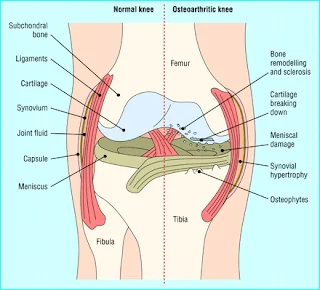Osteoarthritis
Introduction
Osteoarthritis is a chronic musculoskeletal condition that affects the joint and peri-articular structures.
- The changes of osteoarthritis can affect the whole joint, including the cartilage, bone, synovial lining and synovial fluid.
- The most commonly affected joints are those of the hands (particularly the distal interphalangeal joints and the first carpometacarpal joints), the cervical spine, the lumber spine and the knees and hips.
Symptoms
The major symptoms of osteoarthritis are pain, stiffness and swelling, which can lead to impaired mobility and physical function.
- Pain is generally worse in the late afternoon and early evening but can also be worse in the morning soon after waking up.
- Stiffness following inactivity or morning stiffness in osteoarthritis is usually of shorter duration than in rheumatoid arthritis.
- The joint swelling in osteoarthritis may be bony (hard) due to osteophyte formation and/or spongy (soft) due to effusion or synovial thickening.
- Soft-tissue swelling in osteoarthritis is usually not as great as that observed in rheumatoid arthritis.
Deterioration in quality of life is common due to the physical and psychosocial impacts of the condition.
Nonpharmacologic Interventions
Nonpharmacologic interventions are the mainstay of osteoarthritis management and should be tried first, followed by or in concert with medications to relieve pain when necessary.
- Weight management and exercises (e.g. Tai Chi, Yoga)
- Physiotherapy and occupational therapy
- Walking aids and knee braces for patients with malalignment (tibiofemoral or patellofemoral osteoarthritis) may improve pain and should be considered as adjunctive treatments.
- Splints are particularly recommended for the treatment of osteoarthritis at the base of the thumb.
- Surgical treatment is dominated by total joint replacement, which is highly effective in patients with advanced knee and hip osteoarthritis when conservative therapies have failed to provide adequate pain relief.
Pharmacologic Management
Pharmacologic therapy should only be used during periods when symptoms are present since none of the interventions have been shown to be disease-modifying.
For mild to moderate osteoarthritis, consider paracetamol or topical NSAIDs.
Oral NSAIDs is used in patients with inadequate symptom relief from topical NSAIDs, symptomatic osteoarthritis in multiple joints, and/or patients with hip osteoarthritis.
- Use the lowest dose required to control the patient's symptoms on an as-needed basis.
- The use of NSAIDs in most patients is limited by the increased risk of serious gastrointestinal, cardiovascular, and renal complications.
Duloxetine for patients with moderate to severe knee osteoarthritis symptoms and an inadequate response to nonpharmacologic interventions and oral NSAIDs or oral NSAIDs are contraindicated.
Corticosteroid injections are most often used in presence of joint inflammation and effusion (during an osteoarthritis flare) to reduce signs of inflammation (erythema, swelling, warmth, and tenderness), reduce acute pain and increase joint mobility.
- Injections of corticosteroid are not advised more frequently than once every 3 months.
- However, the use of intraarticular glucocorticoid injection may not be routinely recommended due to the short duration of its effects (i.e., approximately four weeks) and evidence that it may have deleterious effects on the hyaline cartilage and may accelerate osteoarthritis progression.
Use of hyaluronic acid injections is controversial due to lack of efficacy and high costs.
Nutritional Supplements
A variety of nutritional supplements have been evaluated in the management of knee osteoarthritis.
There have been conflicting results from randomized trials evaluating the efficacy of glucosamine and chondroitin in knee osteoarthritis.
- Chondroitin for osteoarthritis, 2015
- Glucosamine and chondroitin for knee osteoarthritis: a double-blind randomised placebo-controlled clinical trial evaluating single and combination regimens, 2015
- Dietary supplements for treating osteoarthritis: a systematic review and meta-analysis, 2018
Interest in the use of curcumin, commonly known as turmeric, and Boswellia serrata is largely based on limited data suggesting that these agents have anti-inflammatory and analgesic properties, among others.
- Curcumin is poorly absorbed by the gastrointestinal tract; curcumin supplements formulated to enhance absorption and bioavailability are usually preferred (e.g., combinations of curcumin with piperine or bioperine, a constituent of black pepper).
Other nutritional supplements with limited supporting evidence include vitamin D, diacerein, avocado soybean unsaponifiables (ASU), and fish oil.
External Links
- Daily pain variations among patients with hand, hip, and knee osteoarthritis, 2009
- OARSI guidelines for the non-surgical management of knee osteoarthritis, 2014
- A Randomized, Controlled Trial of Total Knee Replacement, 2015
- Dietary supplements for treating osteoarthritis: a systematic review and meta-analysis, 2018

Comments
Post a Comment